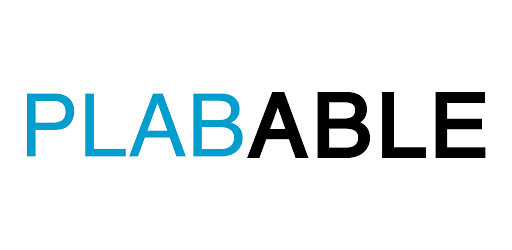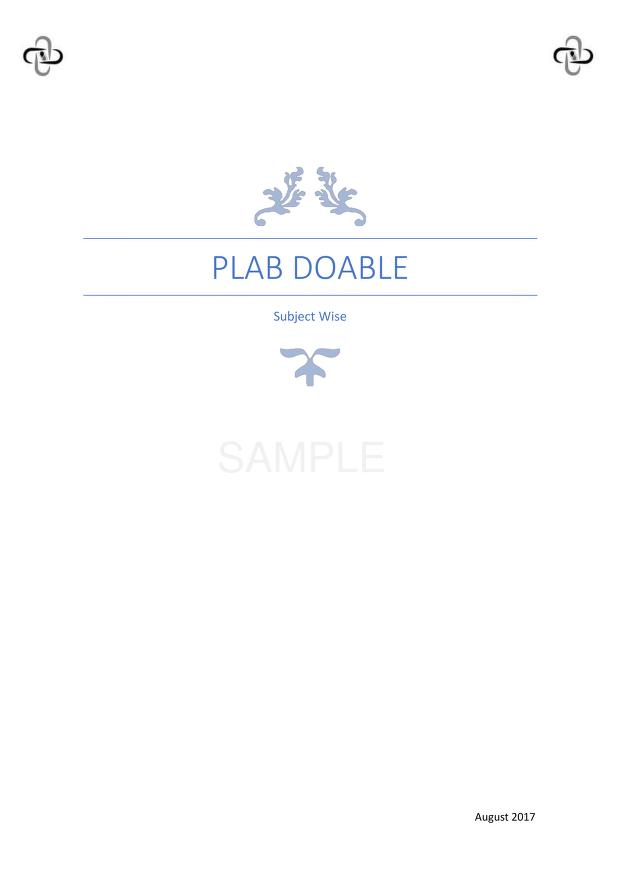Most Important Points for PLAB
Prolong or traumatic cpr, recent trauma and surgery lee than 2
wks, recent head trauma, severe htn, severe liver disease, and
allergy to streptokinase. Pregnancy or less than 18 wks post
deliver (Alteplae has 2 types accelerated with in 6 hrs , young
pts with anterior MI. standard with in 6- 12 hrs.)
(Should be given to all patients except
Haemorrhagic stroke has been excluded.
The patient presents within four and a half hours of having the
event.)(
(Indications:
1-st elevation, posterior infarction,
HAEMOCHROMATOSIS
…….joints, (arthralgia, osteoporosis, pancrease(bronze dm
heart,(dilated cardiomyopathies pituitary,(hypogonadisim and
hypoaldosteronisism liver(cirrhosis).
Is autosomal recessive
Is associated with more ferritin and decrease iron binding capacity. • >50% patients are diabetic • Predispose to
hepatoma • Is caused by absorption of iron Perl’s stain on
liver biopsy for iron loading.
The rooting reflex is present at birth and disappears around four
months of age, as it gradually comes under voluntary control.A
newborn infant will turn his head toward anything that strokes their
cheek or mouth, searching for the object by moving their head in
steadily decreasing arcs until the object is found.
The palmar grasp reflex appears at birth and persists until five or six
months of age. When an object is placed in the infant’s hand and
strokes their palm, the fingers will close and they will grasp it with a
palmar grasp.
Pregnant female exposed to child with chicken pox:-
Next step is measure her IgG antibodies- if she is immune- reassure
If she is non-immune- give varicella Igs
And if she unfortunately develops chicken pox, then give her
acyclovir within a day of appearance of rash (no immunoglobulins
will help her once she develops the disease so avoid)
If fetus develops chicken pox (soon after birth) give both
immunoglobulin and acyclovir A– pale optic disc becoz artery is
occluded
C – dof blot heamorrhages
swelling and edema is always vein
and pale retina with cherry macula is artery block
WILSONS DISEASE The onset of symptoms is usually between 10
– 25 years. Children usually present with liver disease whereas the first
sign of disease in young adults is often neurological disease
Features result from excessive copper deposition in the tissues,
especially the brain, liver and cornea:
liver: hepatitis, cirrhosis
neurological: basal ganglia degeneration, speech and behavioural
problems are often the first manifestations. Also: asterixis, chorea,
dementia
Kayser-Fleischer rings
renal tubular acidosis (esp. Fanconi syndrome)
haemolysis
blue nails
Diagnosis
reduced serum caeruloplasmin
increased 24hr urinary copper excretion
Management
Penicillamine (chelates copper) has been the traditional first-line
treatment
MUST READ:
Primary prevention of cardiovascular disease (CVD):
Previously, aspirin was recommended for those without
apparent CVD in whom the total CVD risk over 10 years is
>20%, and for almost all diabetic patients over the age of 50
years. The evidence to support this unlicensed indication is not
robust and thus current guidance is that aspirin should not be
used in primary prevention (including in those with diabetes
mellitus or hypertension) But note: aspirin is increasingly being
used in the primary prevention of some cancers – particularly
bowel cancer.
Clopidogrel and dipyridamole are neither indicated nor licensed
for primary prevention of cardiovascular (CV) events.
Secondary prevention of CVD:
In those with established atherosclerotic disease, low-dose
aspirin (75 mg daily) is recommended indefinitely for long-term
secondary prevention.
Modified-release dipyridamole 200 mg bd plus low-dose aspirin
(50 mg or 75 mg daily) is recommended for secondary
prevention following an ischaemic stroke or a transient
ischaemic attack (TIA) for a period of two years from the most
recent event,[ Where aspirin is contra-indicated or genuinely
not tolerated (ie proven hypersensitivity or history of severe
low-dose aspirin-induced dyspepsia), clopidogrel 75 mg daily is
a suitable alternative to aspirin (or aspirin plus dipyridamole
post-stroke)
Myocardial ischaemia:
A single dose of aspirin 300 mg and clopidogrel 300 mg (600
mg – unlicensed in some centres prior to urgent percutaneous
coronary intervention (PCI)) should be given as soon as
possible after an ischaemic event (both non-ST segment
elevation myocardial infarction (NSTEMI) and STEMI),
preferably dispersed in water or chewed
Clopidogrel 75 mg daily is licensed for the treatment of acute
coronary syndrome (ACS) ± ST elevation, in combination with
aspirin (usually following loading doses)
Post-PCI clopidogrel 75 mg should continue for one month if a
bare metal stent is inserted and 12 months if a drug-eluting stent
is inserted. Thereafter, treatment should revert to low-dose
aspirin alone.
Eptifibatide and tirofiban are licensed for use with heparin and
aspirin to prevent early MI in patients with unstable angina or
NSTEMI where early percutaneous transluminal coronary
angioplasty (PTCA) is desirable but delay is likely.
Cerebral ischaemia:
Acute ischaemic stroke – thrombolyse if appropriate and follow
with aspirin 300 mg once daily for 14 days. If not able to be
thrombolysed then aspirin alone should be given. Aspirin
caused an excess of about two intracranial and four extracranial
haemorrhages per 1,000 people treated, but these small risks
were more than offset by the reductions in death and disability
from other causes
Long-term management of both TIA or ischaemic stroke –
dipyridamole 200 mg bd with aspirin 75 mg once daily.
Atrial fibrillation (AF) carries a high risk of stroke and other
thromboembolic events. Warfarin is more efficacious than
aspirin at preventing stroke (particularly in those at highest risk)
but carries a greater risk of major haemorrhage:
The CHA2DS2-VASc score is one method of assessing stroke risk (it
has superseded the CHADS2 score)
CHA2DS2-VASc[26]
Condition Points
C Congestive heart failure (or left ventricular (LV) dysfunction). 1
H Hypertension. 1
A2 Age ≥75 years. 2
D Diabetes mellitus. 1
S2 Prior stroke, TIA or thromboembolic disease. 2
V Vascular disease – eg presence of peripheral vascular disease,
myocardial infarction, aortic atherosclerosis. 1
A Age 65-74 years. 1
Sc Sex category (ie female). 1
Score 0 = low risk; no treatment or treat with aspirin.
Score 1 = moderate risk; aspirin daily or warfarin based on the
patient’s preference. Warfarin is probably preferred if there are
no contra-indications.
Score 2 or more = high risk; treat with warfarin maintaining an
INR 2-3.
New oral anticoagulant drugs, eg dabigatran, are likely to become an
option
Fibrinolytic drugs
For patients who cannot be offered PCI within 90 minutes of
diagnosis, a thrombolytic drug should be administered along with
either unfractionated heparin (for maximum two days), a low
molecular weight heparin (eg, enoxaparin) or fondaparinux.
Thrombolytic drugs break down the thrombus so that the blood flow
to the heart muscle can be restored to prevent further damage and
assist healing.
Reperfusion by thrombolysis is often gradual and incomplete and may
be inadequate. There is a risk of early or late reocclusion and a 1-2%
risk of intracranial haemorrhage.
Fibrinolytic drugs act as thrombolytics by activating plasminogen to
form plasmin, which degrades fibrin and so breaks up the thrombi.
Streptokinase and alteplase have been shown to reduce mortality.
Reteplase and tenecteplase are also licensed for AMI.
Streptokinase and alteplase are given by intravenous infusion.
Reteplase and tenecteplase can be given by rapid bolus injection.
The benefit is greatest in those with ECG changes that include ST-
segment elevation (especially in those with anterior infarction) and in patients with bundle branch block.
The earlier the treatment is given, the greater the absolute benefit.
Alteplase, reteplase and streptokinase need to be given within 12
hours of symptom onset, ideally within one hour. Tenecteplase should
be given as early as possible and usually within six hours of symptom
onset.
In patients presenting within 12 hours after the onset of symptoms but
reperfusion therapy is not given, or in patients presenting after 12
hours, aspirin, clopidogrel and an antithrombin agent (heparin,
enoxaparin or fondaparinux) should be given as soon as possible
1:2:1
1:4 25% unaffected
2:4 or 1:2 50% carrier
1:4 25% affected


